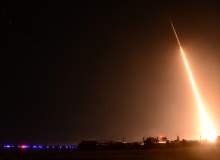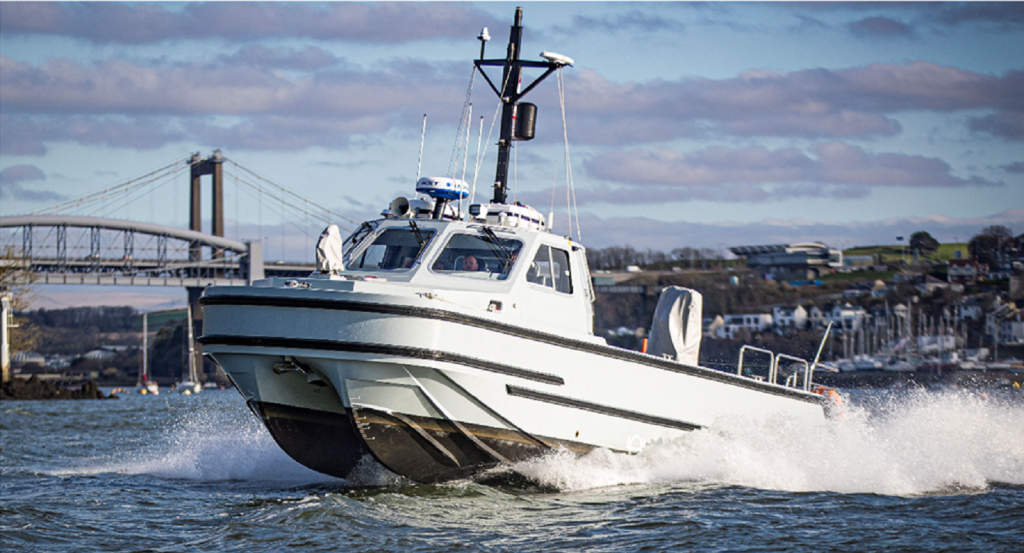

Since 1953, Rota, a small town in Southern Spain, has been home to a sprawling US naval base. It is strategically located near the Strait of Gibraltar and has for six decades provided support for US Sixth Fleet units around the Mediterranean. Now, as part of plans by the US, the base will become a key location for NATO’s expanding ballistic missile defence (BMD) capabilities.
On 11 February 2014, the Arleigh Burke-class destroyer USS Donald Cook sailed into Naval Station Rota. For the residents of Rota, accustomed to seeing warships come in and out every day, it would have looked like a routine docking. But this wasn’t an ordinary vessel. With its advanced radar and sensors, known as the Aegis Combat System, USS Donald Cook is one of the most advanced ships in the world. Importantly for NATO, the ship is capable of tracking and shooting down ballistic missiles mid-flight.
The Donald Cook, the first BMD-equipped ship to be based permanently in Europe, will eventually be joined in Rota by three more US Navy destroyers which have been specially modified for the NATO BMD role.
The deployment is part of the European Phased Adaptive Approach (EPAA), the US’s contribution to NATO’s BMD architecture. NATO BMD aims to protect the people and territory of Europe from the threat of ballistic missiles by pooling resources from each alliance member. NATO will develop the command and control architecture while alliance members will provide the radar sensors and interceptors.
"With the USS Donald Cook in Rota and three other ships arriving, we have four ships and the two systems ashore permanently stationed in Europe; that is quite an impressive capability to protect European populations," said Robert Bell, Secretary of Defense Representative to Europe and defense advisor at the US Mission to NATO. "With these ships stationed in Rota, we can project a missile defence capability much more immediately and responsively in this region."
The evolution of US missile defence
The disappearance of the Malaysian airliner has brought together opposition navies in a rare show of cooperation.
USS Donald Cook’s deployment to Rota is just one piece of a huge missile defence jigsaw which sees US equipment deployed not only to Europe, but in Asia as well. Like Spain, Japan has agreed to host advanced US equipment including ground-based radar (TPY-2) and Aegis ships to protect against threats from North Korea. On 6 April, during a visit to Japan, US Defense Secretary Chuck Hagel confirmed the US would send two more Aegis-equipped ships to the country by 2017.
While on different sides of the world, governments in Europe and Asia share the same worries about the threat from rogue ballistic missiles. Two countries in particular have been singled out as the biggest threats: Iran and North Korea. Both have built up significant ballistic missile capabilities over recent years. This year alone, Iran announced it had perfected multiple-warhead, medium-range ballistic missiles while North Korea has carried out several mid-range ballistic missile tests.
Officials say the threat from ballistic missiles continues to grow and potential adversaries are acquiring a greater number of missiles. They are also increasing their range and, in the words of Vice Admiral J.D. Syring, director of the US Missile Defense Agency, making them "more complex, survivable, reliable and accurate". The missile defence mission is becoming increasingly challenging as adversaries develop BMD countermeasures and space-launch capabilities, says Syring.
"Space-launch activities in Iran and North Korea involve multistage systems that serve to further the development of ballistic missile technology for longer-range systems, including intercontinental ballistic missile-applicable technologies and systems," explains Syring. The US government estimates Iran could develop and test an intercontinental ballistic missile capable of hitting the US mainland as early as 2015. Other missiles could reach key strategic points such as the Persian Gulf or Strait of Hormuz.
Four phases of the European EPAA were meant to be implemented by 2020 in order to meet President Obama’s missile defence goals. The first phase began in 2011 with the deployment of existing Aegis-equipped BMD ships and SM-3 interceptor missiles. The fourth and final phase, scheduled for 2020, would involve deploying even more advanced equipment to counter the potential threat from intercontinental ballistic missiles originating from the Middle East.
Shifting away from Europe and Russia tensions
Early in 2013, the Obama administration announced Phase 4 of EPAA had been cancelled. The deployment of upgraded SM-3 interceptors to Poland at the end of the decade was also shelved. Some analysts saw this as just one example of the US ‘pivot’ strategy towards Asia and the rebalancing of economic and military efforts away from Europe and the Middle East
Some also described the cancellation of Phase 4 as a ‘concessionary measure’ designed to appease Russia. Since Ronald Reagan’s Strategic Defense Initiative in the 1980s, an ambitious plan to counter Soviet intercontinental ballistic missiles, missile defence has been a constant source of tensions between the US and Russia.
In recent years, plans for both a mainland US BMD system and a complimentary NATO system have been heavily criticised by Russia. In 2007, Russia ended its compliance with the 1990 Treaty on Conventional Armed Forces in Europe – which limits military deployments across Europe – in response to NATO’s plans for a missile defence shield. Russia’s Vladimir Putin claimed a NATO missile defence system would shift the strategic balance in favour of the alliance and threaten his country.
Russia and NATO agreed to cooperate on BMD at the Lisbon Summit in 2010, but those talks were suspended in 2014 in light of the recent crisis in Ukraine. In a speech on 4 April, Deputy Secretary-General of NATO Alexander Vershbow said, even before the Ukraine crisis, the scope of Russian-NATO relations was narrowing "as Moscow assumed an obstructionist, zero-sum stance on virtually all major issues" – especially missile defence.
Russia’s land grab in Crimea and aggressive foreign policy towards its neighbours will undoubtedly remind NATO members that missile defence is a vital capability. Equally, US officials will have to reassess to what degree the US diverts resources away from NATO for the Asia pivot.
Even though Phase 4 has been cancelled, the US is still going ahead with Phases 2 and 3. The EPAA is now preparing to enter Phase 2, which will "expand coverage against short- and medium-range threats with the deployment of a land-based SM-3 missile defense interceptor site in Romania". It coincides with an overall ramping up of BMD capabilities available for the US military, whichever theatre they decide has priority.
Bolstering US BMD capabilities
In March 2014, J.D. Syring confirmed the US Navy now has 30 BMD-capable Aegis ships in its fleet. Speaking in front of the House Armed Services Subcommittee on Strategic Forces, Syring said Aegis BMD capabilities will be incorporated into the Navy’s Aegis modernisation programme and new build destroyers.
By 2019, the US Navy plans to have an operational availability of 43 BMD ships.
Only a fraction of these will be assigned to Europe as part of the US’s contribution to NATO’s missile defence plan. Also, the four Rota-based Arleigh Burke class destroyers will patrol the Mediterranean on four month rotations under US command and control – not NATO. In other words, the BMD ships will not just be for missile defence.
Reports on 3 April indicated the USS Donald Cook would sail to the Black Sea in a show of support for Ukraine and other allies after Russia’s annexation of Crimea. If needed, US officials have said the Cook, and other BMD ships, could come back under NATO operational control if the threat conditions warrant it.
The NATO Ballistic Missile Defence programme, as it is known today, was initially established in 2005 as the Active Layered Theatre Ballistic Missile Defence (ALTBMD) programme. At the time it was initially devised as a way to protect deployed NATO forces on operations. The programme was expanded after the NATO Lisbon summit in 2010 and Chicago summit in 2012 to include the protection of NATO European populations and territory. On 1 July 2012, the ALTBMD Programme Office became the NATO Ballistic Missile Defence Programme Office.
A fundamental element of NATO BMD is linking individual nations’ sensors and interceptors (sea and land-based), which are spread all across the continent. Other nations such as the Netherlands are also contributing equipment to NATO Missile Defence. They are upgrading four air-defence frigates with extended long-range "Smart-L" radar systems. Costs for modernising the frigates will be in the region of €100m and €250m.
NATO is aiming for full operational capability of its BMD systems by the first half of the next decade. The programme will be a vital test of NATO’s ability to efficiently use resources and interoperate effectively going into an uncertain future. Many of the lessons learned in Europe will also be transferred to other theatres where BMD cooperation is critical, such as Asia. With the stakes so high, and so many lives at risk from ballistic missiles, an effective missile shield will be vital for many more years to come.
Follow Grant Turnbull on Google+



.gif)




